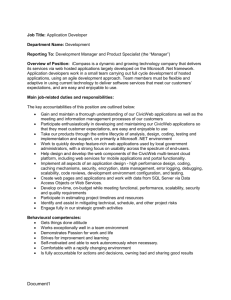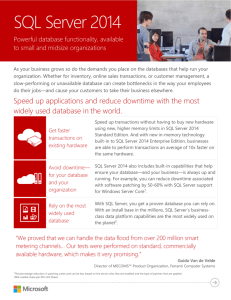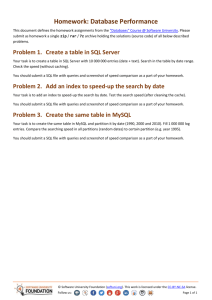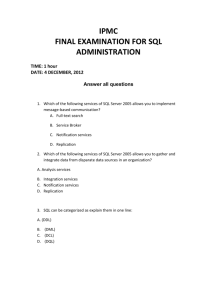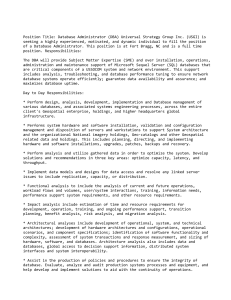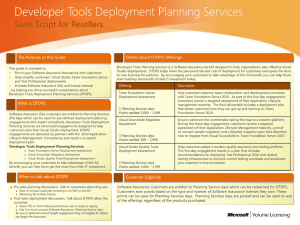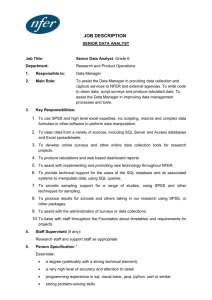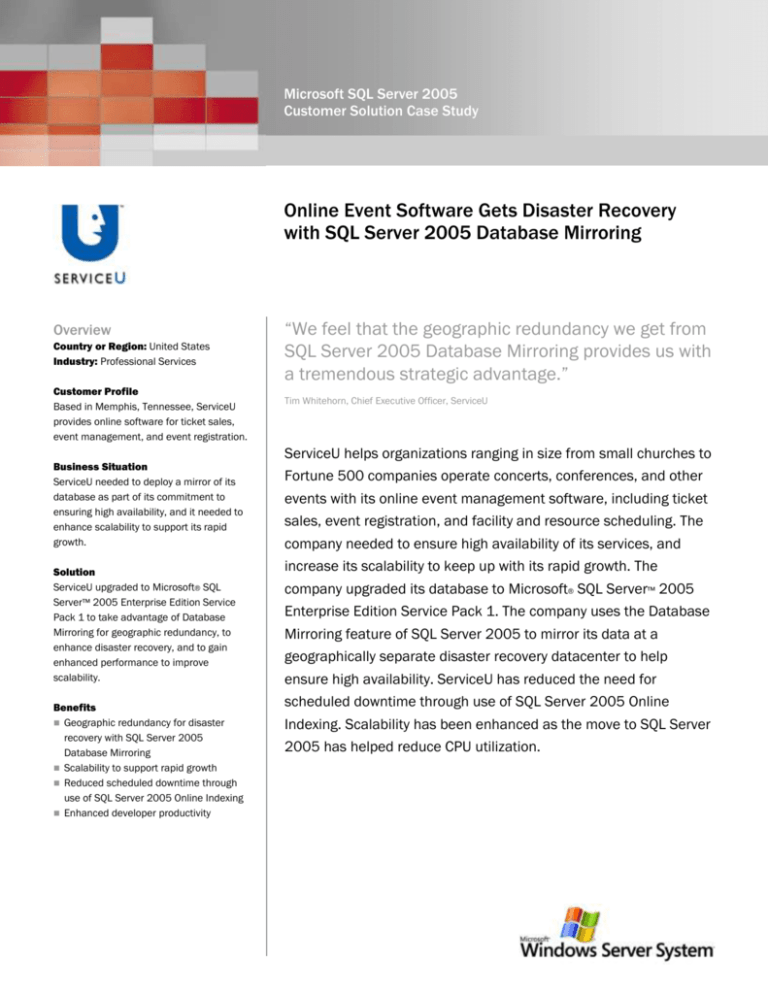
Microsoft SQL Server 2005
Customer Solution Case Study
Online Event Software Gets Disaster Recovery
with SQL Server 2005 Database Mirroring
Overview
Country or Region: United States
Industry: Professional Services
Customer Profile
Based in Memphis, Tennessee, ServiceU
provides online software for ticket sales,
event management, and event registration.
Business Situation
ServiceU needed to deploy a mirror of its
database as part of its commitment to
ensuring high availability, and it needed to
enhance scalability to support its rapid
growth.
Solution
ServiceU upgraded to Microsoft® SQL
Server™ 2005 Enterprise Edition Service
Pack 1 to take advantage of Database
Mirroring for geographic redundancy, to
enhance disaster recovery, and to gain
enhanced performance to improve
scalability.
Benefits
Geographic redundancy for disaster
recovery with SQL Server 2005
Database Mirroring
Scalability to support rapid growth
Reduced scheduled downtime through
use of SQL Server 2005 Online Indexing
Enhanced developer productivity
“We feel that the geographic redundancy we get from
SQL Server 2005 Database Mirroring provides us with
a tremendous strategic advantage.”
Tim Whitehorn, Chief Executive Officer, ServiceU
ServiceU helps organizations ranging in size from small churches to
Fortune 500 companies operate concerts, conferences, and other
events with its online event management software, including ticket
sales, event registration, and facility and resource scheduling. The
company needed to ensure high availability of its services, and
increase its scalability to keep up with its rapid growth. The
company upgraded its database to Microsoft® SQL Server™ 2005
Enterprise Edition Service Pack 1. The company uses the Database
Mirroring feature of SQL Server 2005 to mirror its data at a
geographically separate disaster recovery datacenter to help
ensure high availability. ServiceU has reduced the need for
scheduled downtime through use of SQL Server 2005 Online
Indexing. Scalability has been enhanced as the move to SQL Server
2005 has helped reduce CPU utilization.
“When we turned to SQL
Server Database
Mirroring we saw the
opportunity to save the
$100,000 that a
hardware solution would
have cost, while
avoiding the potential
integration problems
posed by third-party
software solutions.”
David P. Smith, Chief Technical Officer,
ServiceU
Situation
ServiceU is a provider of on-demand event
management software that is used by
churches, schools, businesses, and other
organizations to manage concerts,
conferences, and other events. The Webbased ServiceU solution provides a spectrum
of services including online ticket sales,
online event registration, box office
management, room and resource scheduling,
online calendars, and e-mail newsletters.
Organizations choose the services they want
to make use of from a central control panel,
creating their own custom solutions, and
paying for only the services used. The control
panel also allows organizers to customize the
user experience by setting background colors,
fonts, and even terminology, for example
using ‘Groups’ instead of ‘Departments.’
Since pages can be customized to look like
the customer’s site, visitors to the customer’s
site have a seamless experience, eliminating
confusion and customer service issues. By
outsourcing critical event management
processes to ServiceU, customers avoid the
risks of data security and eliminate the
complexities of in-house software.
Based in Memphis, Tennessee, the company
has customers in all 50 states and 15
countries. ServiceU has been used to
coordinate scheduling for more than 10
million events, serving clients ranging from
small nonprofit organizations to Fortune 500
companies.
ServiceU has built a solid reputation, in part
because of the seamless user experience
and the high availability of the services—both
of which depend on having a robust relational
database to support concurrent users around
the world generating some 2,000
transactions per second. Since moving to an
application service provider (ASP) model in
1998, ServiceU has depended upon
Microsoft® SQL Server™ database. Beginning
with SQL Server version 7.0, and then SQL
Server 2000, the company had always been
happy with SQL Server processing power and
reliability, and has long used Microsoft
clustering technology to ensure high
availability.
“Everything we do in our business—from
transaction processing, to supporting our
applications with business logic, to data
storage—is dependent upon our databases,”
says David P. Smith, Chief Technical Officer
at ServiceU. “We are enjoying rapid growth,
so we need to ensure our infrastructure can
support us well into the future.”
As ServiceU looked toward upgrading its
infrastructure, it needed a relational
database that would support:
Geographic redundancy to help ensure that
its users worldwide would always be able
to access their ServiceU solution, even in
the event of a natural or man-made
disaster.
Scalability to support future growth.
Online indexing to reduce impact on users
during database maintenance.
Transparent upgrade of databases to
enable use of existing stored procedures.
Enhanced developer productivity, as
ServiceU creates its own applications.
Solution
ServiceU upgraded to Microsoft SQL Server
2005, and recently installed SQL Server
2005 Service Pack 1 to take advantage of
the SQL Server 2005 Database Mirroring
feature, which provides geographic
redundancy for disaster recovery of data. SQL
Server 2005 is part of Microsoft Windows
Server System™ integrated server software.
Using its own internal developers, ServiceU
created its hosted software using the
Microsoft Visual Studio® 2005 development
system and SQL Server stored procedures.
The company has used an n-tier architecture
that includes:
Solution Architecture – ServiceU
architecture includes a
presentation tier, an
application tier with workflow
and business rules, and the
data tier.
Presentation Tier. Customers access the
ServiceU site using a browser, avoiding the
need for downloading client-side
applications. The options users see are
determined by the services selected by the
customer’s administrator who uses a
ServiceU control panel to pick and choose
the services. The presentation tier uses
Internet Information Services (IIS) Web
server technology in the Microsoft Windows
Server™ 2003 operating system. The
Presentation tier is hosted as a Web farm
using Windows Server 2003 Network Load
Balancing to dynamically distribute traffic
across Dell PowerEdge 2850 servers, each
with two processors and two gigabytes (GB)
of RAM. Windows Server 2003 is the
foundation of Microsoft Windows Server
System integrated server software.
Service-Oriented Architecture. ServiceU
offers customers the ability to use its
solution to create their own applications,
using ServiceU for backend processing.
Application Tier. The application tier
includes a number of custom business
objects ServiceU developers created to
apply rules for ticketing, scheduling
resources, checking for conflicts, handling
payments, and other key functions. The
application tier is co-hosted on the same
servers as the presentation tier.
Database Tier. ServiceU stores some 120
GB of data, with more than 20 million rows
in the largest table, in a relational
database hosted on a single named
instance of SQL Server 2005. The
database tier is hosted on a three-node
active/passive cluster using Dell
PowerEdge 2850 64-bit servers, each with
8 GB of RAM.
Mirrored Database. To provide high
availability of data, ServiceU is using the
Database Mirroring feature of SQL Server
2005 to provide an asynchronous mirrored
copy of data to a cluster at the company’s
disaster recovery data center in Atlanta,
Georgia. Database mirroring transfers
transaction log records directly from one
server to another and can quickly fail over
to the standby system, with no loss of
committed data. The mirror database
cluster also runs on SQL Server 2005
Enterprise Edition and Windows Server
2003 Enterprise Edition.
Benefits
ServiceU has enjoyed a number of benefits
since upgrading to SQL Server 2005 Service
Pack 1, including geographic redundancy
utilizing SQL Server 2005 Database
Database Mirroring – Data from
the Memphis headquarters is
mirrored to the company’s
disaster recovery site in
Atlanta.
Mirroring, scalability to support rapid growth,
reduced scheduled downtime through use of
Online Indexing, and enhanced developer
productivity.
uptime, so after we opened our disaster
recovery data center in Atlanta last year we
began moving forward with plans to mirror
our databases to that site.”
Geographic Redundancy with SQL Server
2005 Database Mirroring
Ensuring its customers get the best service
possible is at the foundation of ServiceU’s
success. “We recognize that our business is
delivered completely over the Internet, and if
we were to have an infrastructural problem it
would adversely affect the customer’s
experience, so we are very serious about
minimizing downtime,” says Smith. “We take
every measure that is feasible to ensure
The company looked at a range of possible
solutions, including a hardware-based
mirroring system that would have cost the
company U.S.$100,000 in the first year and
continuing licensing fees. The company also
considered a third-party software-based
solution, but it posed significant potential
integration issues.
“When we turned to SQL Server Database
Mirroring we saw the opportunity to save the
$100,000 that a hardware solution would
have cost, while avoiding the potential
integration problems posed by third-party
software solutions,” says Smith. “We wanted
a single-vendor solution so there could be no
finger pointing if something went wrong. Our
production system is our business, our
livelihood. We must protect the interests of
our customers. We don’t have room for
mistakes, or ongoing issues. We need to be
able to contact one support team if there is
ever an issue so that we can quickly resolve
the problem.”
In all SQL Server databases, data changes
are recorded in the transaction log before any
changes to actual data pages are made. The
transaction log records are placed first in a
database's log buffer in memory, and then
flushed to disk (or 'hardened') as quickly as
possible. In Database Mirroring, as the
principal server writes the database's log
buffer to disk, it simultaneously sends that
block of log records to the mirror instance.
“The latency between our Memphis facility
and our Atlanta facility is only 10 milliseconds
—even with our triple DES [168-bit Data
Encryption Standard] encryption,” says Smith.
“This allows us to use asynchronous mirroring
“Home pages for our
largest customers, that
once took two to three
seconds to load, now
open in 200 to 300
milliseconds because of
[SQL Server 2005]
Indexed Views.”
Micky McQuade, Software Engineer, ServiceU
and commit the data to the Atlanta facility
extremely quickly.”
Mirroring the database was especially
important to the company because of
Payment Card Industry (PCI) security
certifications with which ServiceU must
comply. The PCI security certifications are
the credit card industry’s way of insuring that
cardholder data that is transmitted or stored
is secure. Depending on the transaction
volume and other factors, a company may
have to certify at one of several levels, which
can include vulnerability scans, penetration
scans, internal audits, network infrastructure
requirements, specific encryption levels, and
detailed policies and procedures that dictate
the company’s reaction in different
situations.
“We are a level-one PCI service provider,
which is the highest level of certification,”
Smith says. “This is an audited security
certification, and there are rigorous
requirements which must be met. In order to
bring our systems online at a different facility
after a disaster, we must show that we have
implemented all of the level one PCI security
precautions.”
By implementing Database Mirroring and
keeping both sites certified, the company can
very quickly make its Atlanta datacenter the
primary facility in a disaster.
“This saves us what could be days or even
weeks to both restore from tape and
implement the numerous safeguards
required by the payment card industry,” says
Smith. “Database mirroring is essential to
this process, as it allows us to have the entire
geographically redundant site functional,
certified, and ready to use at a moment’s
notice.”
The company views its ability to provide high
availability as a great marketing tool. “We feel
that the geographic redundancy we get from
SQL Server 2005 Database Mirroring
provides us with a tremendous strategic
advantage,” says Tim Whitehorn, Chief
Executive Officer at ServiceU. “We know that
significant downtime for our customers would
not only cause them an inconvenience, it
would have a serious marketing impact on
us. We now view our network’s reliability and
redundancy as a major strategic factor for
marketing our services. We compete against
extremely large service providers. With
database mirroring, network load balancing,
and our other precautions, we have trumped
the technical capabilities of our competition.”
Scalability to Support Rapid Growth
ServiceU is enjoying steady growth, so it is
concerned about scalability. Its previous
database, running on SQL Server 2000 and
Windows® 2000 Server, and hosted on
servers with four Xeon 700 processors and 4
GB of RAM, often ran at 40 percent to 60
percent of CPU capacity, not leaving much
room for growth. ServiceU’s policy is to
upgrade servers and bandwidth when they
reach 60 percent of capacity. Due to this and
the added need for geographic redundancy,
ServiceU planned a hardware and software
upgrade to SQL Server 2005.
After the company upgraded to SQL Server
2005 running on Windows Server 2003,
hosted on servers with dual 3.8 gigahertz
hyperthreaded processors, CPU utilization
dropped to just 4 percent. “As soon as we
started working with SQL Server 2005 we
could see that it was much more efficient
than SQL Server 2000,” says Smith. “With the
combination of SQL Server 2005, Windows
Server 2003, and the newer hardware, we
were expecting a drop in CPU utilization, but
we were astonished to see it go down to just
four percent. We were very pleased. In
addition, the ease of adding nodes to the SQL
Server cluster means that we can increase
“With SQL Server 2005
Online Indexing those
index-related
maintenance and
downtime problems
went away. Online
Indexing has proven
crucial to our efforts to
reduce scheduled
downtime.”
David P. Smith, Chief Technical Officer,
ServiceU
computing power by adding new hardware
very easily—and literally within minutes.”
“As the CEO of a company that is in a rapid
growth mode, it was tremendous to see our
CPU utilization drop to less than 5 percent,”
says Whitehorn. “We have so much room to
grow on our servers, that it made the entire
upgrade project extremely worthwhile. We
can grow our business without having to
worry about additional database upgrades in
the immediate future.”
The company found the Indexed Views
feature of SQL Server 2005 significantly
enhanced performance in key areas,
including the display of a user’s home page,
which provides a personalized listing of
events that are waiting on approval. This
information is pulled from tables, which
contain millions of approved events, with only
a small percentage that are pending
approval.
“With the implementation of SQL Server
2005 Indexed Views on the Status Column of
the customer’s home page, we were able to
gain extraordinary and immediate
improvements in performance with very few
code changes,” says Micky McQuade,
Software Engineer at ServiceU. “Home pages
for our largest customers, that once took two
to three seconds to load, now open in 200 to
300 milliseconds because of Indexed Views.”
Online Indexing to Reduce Scheduled
Downtime
When your customer base spans the globe, it
is extremely difficult to find a maintenance
window that doesn’t affect someone. With
SQL Server 2000, indexes were rebuilt once a
month, requiring scheduled downtime.
“We have customers in North America,
Europe, Asia, as well as Australia, so we don’t
have a natural maintenance window,” says
Smith. “We used to have to rebuild our
indexes once a month. To minimize downtime
we would defragment the indexes prior to
going down to rebuild them, but during the
defragging process the system
responsiveness for users suffered. With SQL
Server 2005 Online Indexing those indexrelated maintenance and downtime problems
went away. Online Indexing has proven
crucial to our efforts to reduce scheduled
downtime.”
Enhanced Developer Productivity
ServiceU, which creates its own applications
using Microsoft Visual Studio 2005 and SQL
Server 2005, has long benefited from the
efficient development environment provided
by Visual Studio and SQL Server. Developer
productivity has been further enhanced with
SQL Server 2005 native support of XML as a
data type, and user-defined functions.
“Having native support for XML in SQL Server
2005 has greatly simplified the process of
responding to customer requests for new
features,” says Smith. “Support of XML gives
us greater flexibility in working with stored
procedures. We are always interested in
responding to customer requests for new
functionality, and XML support is allowing us
to do so two to three times faster than we
previously could.”
Development time is reduced through the use
of user-defined functions, because common
functionality can be introduced as a separate
entity, without having to insert the full code
into each stored procedure. “A simple
example is the ability to verify the format of
data from the calling application before
inserting it into the database,” says Smith.
“The code for these functions is very small,
but with user-defined functions, which we
began using as soon as it was introduced
with SQL Server 2000, the code can now
reside in one place rather than in every
stored procedure that needs it.”
For More Information
Microsoft Windows Server System
For more information about Microsoft
products and services, call the Microsoft
Sales Information Center at (800) 4269400. In Canada, call the Microsoft
Canada Information Centre at (877) 5682495. Customers who are deaf or hard-ofhearing can reach Microsoft text telephone
(TTY/TDD) services at (800) 892-5234 in
the United States or (905) 568-9641 in
Canada. Outside the 50 United States and
Canada, please contact your local
Microsoft subsidiary. To access information
using the World Wide Web, go to:
www.microsoft.com
Microsoft Windows Server System integrated
server infrastructure software is designed to
support end-to-end solutions built on
Windows Server 2003. It creates an
infrastructure based on integrated
innovation, Microsoft’s holistic approach to
building products and solutions that are
intrinsically designed to work together and
interact seamlessly with other data and
applications across your IT environment. This
helps you reduce the costs of ongoing
operations, deliver a more secure and
reliable IT infrastructure, and drive valuable
new capabilities for the future growth of your
business.
For more information about ServiceU
products and services, visit the Web site at:
www.ServiceU.com
For more information about Windows Server
System, go to:
www.microsoft.com/windowsserversystem
Software and Services
© 2006 Microsoft Corporation. All rights reserved. This case
study is for informational purposes only. MICROSOFT MAKES NO
WARRANTIES, EXPRESS OR IMPLIED, IN THIS SUMMARY.
Microsoft, Visual Studio, Windows, the Windows logo, Windows
Server, and Windows Server System are either registered
trademarks or trademarks of Microsoft Corporation in the
United States and/or other countries. All other trademarks are
property of their respective owners.
Document published April 2006
Hardware
Microsoft Windows Server System
Dell PowerEdge 2850 servers with dual
− Microsoft Windows Server 2003
processors and 2 GB of RAM for
Enterprise Edition
presentation and application tiers
− Microsoft SQL Server 2005 Enterprise Dell PowerEdge 2850 servers with dual
Edition Service Pack 1
processors and 8 GB of RAM for database
Microsoft Visual Studio 2005
tier
Technologies
− Microsoft Internet Information Services

